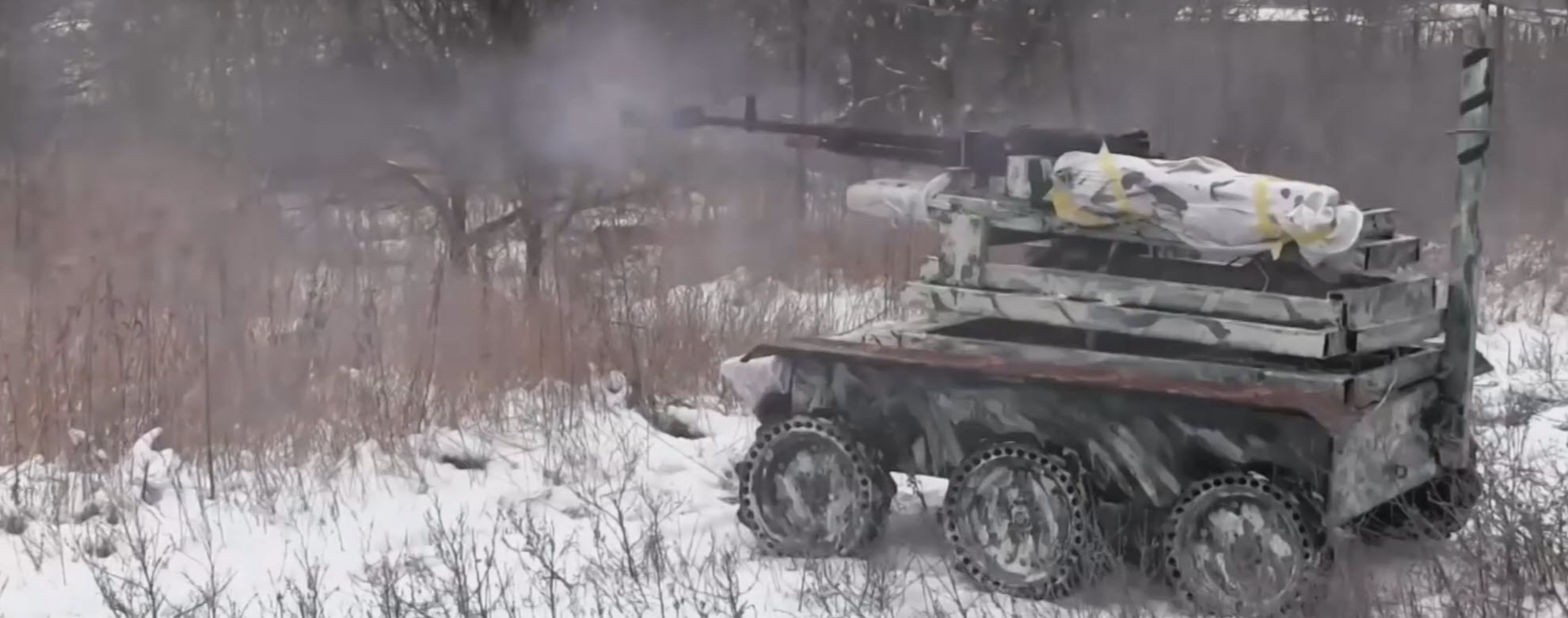#MinskMonitor: Ukrainian Killer Robots
How a volunteer engineering project became a start-up successstory
#MinskMonitor: Ukrainian Killer Robots

How a volunteer engineering project became a start-up success story

In May 2017, Ukraine’s Pershy channel (First, or UA:First) aired a documentary with footage taken while reporters were embedded with Ukrainian Armed Forces soldiers near Avdiivka, on the frontlines of the war in the Donbas. The documentary featured a portion in which Ukrainian soldiers used a remote-controlled turret on six wheels and with an attached camera to fire at Russian-led separatist fighters in a nearby house.
In other words, the UAF weaponized robot in the tradition of a teletank, which was used in the 1930s and 1940s by the Soviet Union.

Avdiivka Deployment
Ukrainian Twitter user @tiamat007 recently shared a screenshot from a re-airing of the documentary, which showed what he described as a “turret” firing.
Турелька на дист. управлении pic.twitter.com/3dSFk2uIQT
— Летов Егор (@tiamat007) January 20, 2018
During the documentary, Ukrainian soldiers audibly discuss and demonstrate how this machine was used. They were trying to clear out Russian-led separatist fighters from a house in the Avdiivka “Promzona,” the industrial area in the southeast part of the city near the frontlines. The exact image of what the Ukrainian soldiers saw through a front-facing camera mounted on the robot is included below.

The Ukrainian soldiers were using an interface sent from the robot to a computer, with an interface that showed multiple camera perspectives.

The robot was operated through a set of controls, with the operator manning the vehicle similar to how an operator would drive an unmanned aerial vehicle (UAV).

After lining up the target with help from a nearby soldier with a sniper rifle scope and binoculars, the operator activated the robot’s machine gun (a 12.7mm “Utyos”) and fired at the target.

YouTube user Ivan N, who has uploaded a number of videos related to Ukrainian lethal robots, uploaded footage on May 7, 2017 depicting the same place and time from a different camera featured above. He noted that the incident took place in December 2016, which matched with events in the documentary.
Development of the “Hunter” Robot
The robot used in Avdiivka in December 2016 was shown at an exposition in Kyiv in October 2016 by the “Kolo” charity fund. According to the “Kolo” representatives, the robot (or “Cyber Soldier,” as it is called in the video) was developed with only $10,000 by a group of Donbas-native volunteers. The full video recorded on a screen during the expo can be found on Ivan N’s YouTube account here.
The robot shown at the expo resembled the one that took part in the battle around Avdiivka, but the battle version clearly included improvements campared to the bare-bones structure from October 2016.

The user interface shown during the demonstration in October 2016 was the same as the one seen in the Avdiivka documentary, with the main camera view in the top-left of the screen, four alternate views along the bottom row, and four in a vertical column on the right side.

The demonstration also revealed killer robot has a name — the Hunter (Мисливець). The Kolo fund demonstrated the Hunter’s use in various tests before it made its way to Avdiivka, where it would take the place of soldiers on the battlefield.


The creators of the Hunter later discussed how it was used in the ATO zone, and how, starting in January 2017, two Hunter robots “successfully carried out military tasks in the ATO zone.”
Hunter, Mark 2
The Hunter did not stop its development after deployment to Avdiivka. After initially built by a small group of volunteers with the Kolo fund on a shoe-string budget, the Kyiv-based firm called “Robotics” designed improvements. The “Robotics” firm has only two products — a weaponized and non-weaponized version of the Hunter, which indicated that it was created out of the Kolo charitable fund to market and sell the robot.
A photograph of the upgraded Hunter 2 was shared from a Kyiv expo from October 2017.
“What started as a volunteer project two years ago is gaining momentum and becoming self-sufficient.”
The upgraded Hunter, with an improved hull and user interface, was been shown off to defense analysts in Ukraine through 2017 and 2018. A 2017 video from Ivan N’s YouTube account showed the robot in action with a far more intuitive, user-friendly interface.
The second version of the Hunter has a number of upgraded capabilities, including: a thermographic (infrared) camera, a movement range of between 1500 and 3000 meters (depending on upgrades), an encrypted signal transmitted back to the control post, and a 36-hour battery life between charges.

Conclusion
The Hunter is a clear success story in the Ukrainian defense industry, going from a start-up using relative pocket change for defense research & development to a successful deployment in one of the hottest spots of the war in the Donbas. The project started as a volunteer effort to help improve Ukraine’s situation on the frontline and turned into a legitimate business.
Ukraine’s largest defense company is following close behind. In October 2016 — at almost the same time that the Hunter was first shown off — UkrOboronProm premiered the “Phantom,” an advanced robot that strongly resembles the Hunter, with additional capabilities and modernizations.

The combination of Ukraine’s robust supply of highly-educated workers trained in engineering and the necessity of innovation in the ongoing war in the Donbas has led to the frontline becoming a laboratory for new creations, both makeshift and more technologically advanced. The Hunter will likely have more future successful deployments and could lessen the human costs in Ukraine’s already-strained military.
Editor’s Note: Special thanks to the Conflict Intelligence Team (CIT) for research assistance in this article.
Follow the latest Minsk II violations via the @DFRLab’s #MinskMonitor.
Also, follow @DFRLab on Twitter for more in-depth analysis from our #DigitalSherlocks.

